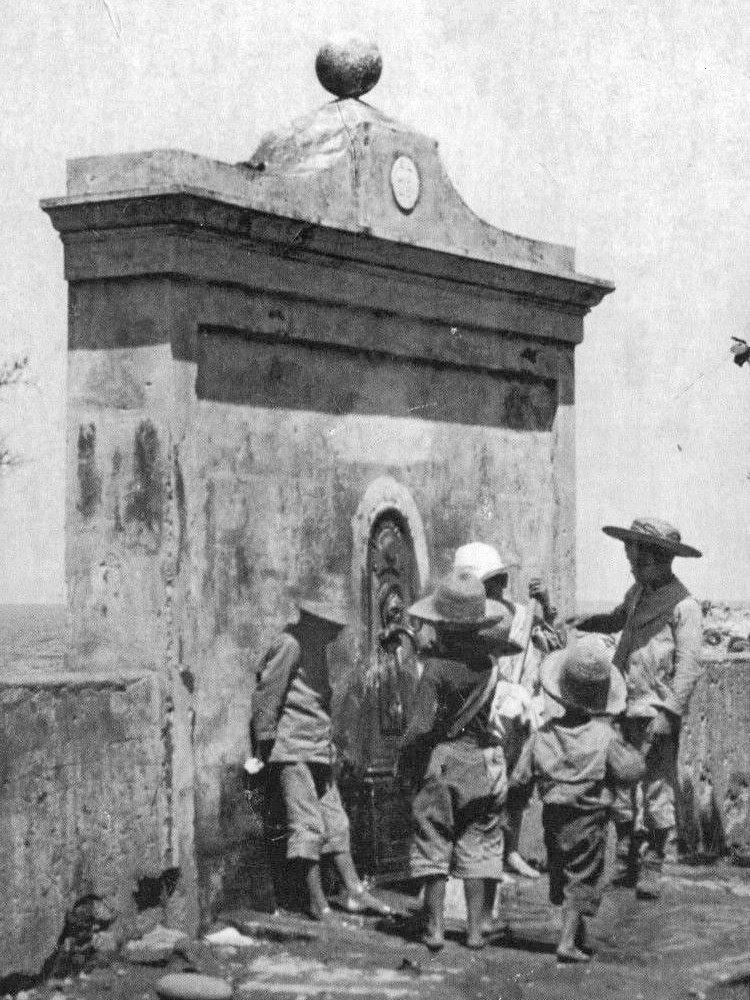
Italian Islands: Elba--History

Figure 1.--Elba is an Italian island despite its best known point in French history as where the Great Powers placed Napoleon (1814). The population is Italian, meaning a composit of many different peoples of the Italian peninsula, including a tribal people, the Etruscand and Romans as well as smaller numbers of a very wide range of mostly Mediterranean peoples. The photo shows a group of children at the public fountain in Marciana about 1900. Notice that all of the children have hats to provide some shade from the sun. The wide-brimmed hats bearing some resemlance to the Roman petasus. Only one of them is shod. That was also very common at the time, even more so on an island.
|
|
Elba has not featured prominately in history, but it has a long history. Many civilizations have inhabited the island. The first inhabitants were the Ligures Ilvati and as a result was called lva in ancient times. The first inhabitants were the Ligures Ilvati and as a result was called lva in ancient times. It was renounded for its iron resources and mines. The Greeks called it Aethalia (fume) because of the metal smelting furnaces. The Etruscans seized the island and then the Romans (about 480 BC). After the fall of Rome the island was pillaged by first barbarians and then, like other Mediterranean islands, the Saracens. During the medieval period it was transferred to several different principalities. With the rise of French power during the Napoleonic era, the island became a French possession, and its economy flourished as never before (1802). With Napoleon's fall, inder the terms the Treaty of Fontainebleau, Napoleon was exiled to Elba after his forced abdication (1814). Napoleon arrived at Portoferraio (May 30, 1814). He was permitted to keep a personal guard of 600 men. elba under Napoleon was a sovereign pincipality. The British fromthe beginning were on edge. Napoleon's Elba was patrolled by the Royal Navy. Napoleon threw himself into the task of modernizing the island, both econonomic and social reforms. He gave a lot of attention to the roads. This was his very nature, but from an early point he saw Elba as not a worthy task for a ruler of his genius. He was determined not to be confined to Elba. Napoleon remained on Elba for less than a year--300 days. He embarked for France and after aluding Royal Naval patrols, a new attempt at power (February 26, 1815). His adventure lasted a Hundred Days. With his defeat at Waterloo he was exiled again, this time to the desolate South Atlantic island of Saint Helena. The Congress of Vienna allocated Elba to the Grand Duchy of Tuscany (1815). The island as Italian unification prigressed subsequently became part of the new unified Kingdom of Italy (1860).
HBC

Navigate the Boys' Historical Clothing Italian pages:
[Return to the Main Elba page]
[Return to the Main Italian island page]
[Return to the Main Italian regional page]
[Return to the Main Italian activity page]
[Return to the Main Itlalian page]
[Italian school uniforms]
[Italian youth groups]
[Italian choirs]
[Italian movies]
[Italian royalty]
Navigate the Boys' Historical Clothing Web Site:
[Introduction]
[Activities]
[Biographies]
[Chronology]
[Clothing styles]
[Countries]
[Bibliographies]
[Contributions]
[FAQs]
[Glossaries]
[Images]
[Links]
[Registration]
[Tools]
[Boys' Clothing Home]
Created: 12:12 AM 12/11/2015
Last updated: 12:12 AM 12/11/2015



